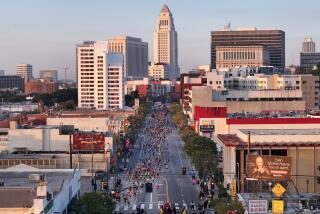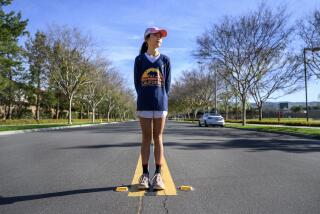The Running Business
- Share via
Either road runners are becoming bigger and beefier--or they’re succumbing to fashion-consciousness. That’s the view of race directors, who say that athletes increasingly spurn small T-shirts for oversized ones. Until recently, the New York Road Runners Club ordered 30% small T-shirts, 40% medium, 30% large and 10% extra-large, President Fred Lebow said. But the new demand for big shirts has forced a change to 10% small, 20% medium, 50% large and 30% extra-large.
Lebow blames “a fashion look. . . . Little women come over and they want extra-large. What they do is they take the shirts and tie them around themselves. It’s incredible.”
About 1.2 million Americans participated in road races last year, according to TACStats, the statistics section of the Indianapolis-based Athletics Congress, a national sports organization. The overall number of road racers has stayed roughly the same for the last 10 years, managing trustee Basil Honikman said.
A majority of these athletes--700,000--ran in one of the nation’s 100 largest races. These are pretty much the only events that offer cash prizes, Honikman said. But another 6,000 smaller events were advertised in running magazines, and a probably equal number of tiny events took place with virtually no advertising.
Putting on even a short road race is not cheap. For example, Union Bank shelled out roughly $60,000 to organize this year’s Heart of the City 5-kilometer run in downtown Los Angeles on June 29. The race drew nearly 3,000 runners and raised $179,898 for the American Heart Assn.
T-shirts, hats, mugs, buttons and other supplies were the biggest single expense at $32,000, said Heidi H. von Kann, the bank’s manager of special events. Race day expenses totaled $13,300, and included a live band, parking security and $4,000 for off-duty police and traffic control officers.
Another $10,000 was divided among Race Central, a Rialto firm that organized the finish line; Los Angeles-based Professional Road Race Organizers, which arranged for permits and set up race course markers and mid-course timers, and a pace car driver for the lead runners to follow through the course. Finally, advertising in running magazines and small local newspapers cost another $2,000, while graphics and printing charges totaled another $1,200, von Kann said.
The race’s overall cost has doubled since its establishment in 1985, when only 1,400 runners participated. As a result, von Kann said, Union Bank is trying to find other companies to share the burden by sponsoring the race’s finish line next year.
Tobacco and alcohol companies remain controversial sponsors of road races. G. Heileman Brewing Co., a La Crosse, Wis.-based firm, has adopted Chicago’s marathon and renamed it the Old Style Marathon in honor of its major brand of beer. The company is also a co-sponsor of the Twin Cities Marathon in Minnesota.
A major tobacco company recently asked to sponsor the New York Marathon, and wanted to distribute free cartons of cigarettes at the finish line, race director Lebow said. He turned the offer down flat. “I told them it’s ridiculous. 99% of the runners don’t smoke,” he said, adding that the company, which he refused to identify, may have hoped for publicity at the marathon’s expense.
Lebow recalled seeing Winston cigarettes distributed in packages and singly on trays after running a marathon in Marrakech, Morocco, on Jan. 15. But he added, “I didn’t see anyone take the cigarettes.”
More to Read
Go beyond the scoreboard
Get the latest on L.A.'s teams in the daily Sports Report newsletter.
You may occasionally receive promotional content from the Los Angeles Times.










